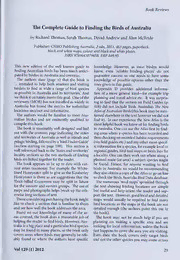Table Of ContentBookReviews
The Complete Guide to Finding the Birds ofAustralia
byRichard Thomas, SarahThomas, DavidAndrewandAlan McBride
Publisher: CSIROPublishingAustralia, 2edn,2011. 463pages,paperback,
blackandwhitemaps, colourandblackandwhiteplates.
ISBN9780643079858. RRP$49.95
This new edition ofthe well known guide to knowledge. However, as most birdos would
findingAustralianbirdshas been much antici- know, even ‘reliable birding places’ do not
patedbybirdosinAustraliaandoverseas. guarantee success so one needs to have some
The authors state (page x) that the book is knowledge ofpossible options other than the
intended to help both resident and visiting onesgiveninthisguide.
birders to find as wide a range ofbird species Appendix D provides additional informa-
as possible in Australia and itsterritories.’ And tion ofa more general kind—for example trip
wethinkitcertainlymeetsthisgoal. Oneofthe planning and travel advice etc. It was surpris-
reviewers (MOB) hasnot travelledaswidelyin ingto find that the section on Field Guides (p.
Australia but found the entries for unfamiliar 418) did not include Birds Australia’s The New
locationssuccinctandinformative. AtlasofAustralianBirds(thisbookmaybemen-
The authors would be familiar to most Aus- tionedelsewhereinthetexthoweverwedidnot
tralian birdos and are eminently qualified to findit). Inourexperience theNewAtlas is the
compilethisbook. mosthelpfulbookwe knowofforfindingbirds
Thebookisreasonablywell designed andlaid inAustralia.OnecanusetheAtlasfirstbyfind-
out with the contents page indicating the states ingareaswhereaspecieshasbeenrecordedand
andterritoriesofAustraliaaswellasislandsand thencheckingonrecordedhabitatrequirements
pelagicbirding,followedbya‘birdFinderGuide (viafieldguidesetc.)andanyothermorespecif-
(section starting on page 199). This section is icinformationforaspecies,forexamplelocalor
wellreferencedbacktothe‘Statesandterritories’ regionalguides,birdtrailmapsorbirdslistsfor
locality sections so the two methods offinding alocality. Onecanthenworkoutwherealonga
birdsarelinkedtogetherforthereader. planned route (or area) a subject species might
The book appears to be up to date with cur- be found. Hence, for anyone wanting to find
rent avian taxonomy. For example the White- birds in Australia we would be recommending
linedHoneyeatersplittogiveus theKimberley theyalsoobtainacopyoftheAtlasorgoonline
Honeyeater is there as are suggestions that the tochecktheBirdsAustraliaBird Datadatabase.
Thick-billed Grasswren may be split in future Thenumerous‘mudmaps’ sprinkledthrough
forthewesternandeasterngroups. The use of the text showing birding locations are simple
mapsandphotographshelpsbreakuptheoth- but useful and help orient the reader and sup-
erwiselongsectionsoftext. portthetext. However,goodlocalanddetailed
Thoseconsideringpurchasingthebookmight maps would usually be required to find many
like to check a section that is familiar to them bird locations as the maps in the book are not
andseehowwellthebookaddressesthearea. detailed enough (the authors point this out in
Based on our knowledge ofmany ofthe ar- thebook).
eas covered, the book does a reasonablejob of The book may not be much help ifyou are
helpingthereaderto findbirds. However,Aus- planning on visiting a specific area and are
traliaisabigplaceandaparticularbirdspecies looking forlocal information, unless the book
maybe found in manyplaces, sothebookonly just happens to coverthe areayou arevisiting.
covers areaswhere birdsmaygenerallybe reli- Even then the book covers only target birds
ably found or where the authors have specific and nottheotherspeciesyoumaycomeacross
Vol 129 (1)2012 29
BookReviews
riu-C'oniplrU’(niuk-to Kimlitigthi- is not designed as a comprehensive site guide
...’ and that they ‘... have madejudgements as
Birds of to where to find as manyofAustralias birds as
possible in the mostefficientway’ (pagex).
In thesedaysofinternetaccessto the vari-
Australia ous state 'BirdLine websites, birding chatlist
(Birding-Aus),interactiveeBooks (e.g. Michael
SKCONt)KDmON Morecombe’s Field Guide) and access to de-
tailed topographic maps via hand-held GPS
devices, birding guide books have plenty of
competition in attracting the attention ofthe
birdingfraternity,especiallythosevisitingAus-
traliatofindbirds.
However,thisisaveryusefulbooktoalllevels
of interested naturalists and makes a valuable
addition to ones ‘birding kit’ (along with the
other resource tools and research mentioned
above). In addition to a number ofrecent and
excellentregionalguides(e.g. WheretoseeBirds
in Victoria, Birds Australia 2009), this nation-
widebookisworth purchasingbyallbirdos.
The guide is awelcome and long-awaited ad-
ditiontotheincreasinginformationavailableto
Richard'I'homas.SarahTliomas, birdos in Australia and wecan heartilyrecom-
DavidAndrewandAlanMcBride mend it as reference material for both visitors
to Australia and to anyone heading to a new
in the area. For example we purchased a copy location.
thinkingitwouldhelp with atripto north-east
NSW/south-east Qld. However, we found that John Hutchison
this bird-rich area with alarge human popula- Bairnsdale
tion and many visitors was not generally cov- andMartin 0*Brien
ered. However, our target area (Bowra Station) ThreatenedSpeciesCommunitiesSection
was coveredbutonlytoalimitedextent. Tobe DepartmentofSustainabilityandEnvironment
fair, the authors do mention that ‘... this book East2M/e8lbNiocuhronleso3n00S2t
Onehundred andtwenty-eightyearsago
THEPROTECTIONOFOURNATIVEBIRDS
ByA.J.Campbell
(ReadbeforethefieldNaturalists’ClubofVictoria,9thFeb., 1885)
... Thereisacircumstancethatgreatlyinterfereswithourbirds,andtowhichtheydonotappear,likethe
birdsofEuropeorAmerica, to be abletoadaptthemselves,viz., thealteration ofthe physical featuresof
thecou—ntrybytheadvanceofcivilization andcultivation.Then thereisthe havocmadewith indigenous
forests theirnaturalresorts.OurLandAdministratorsseemtoalienateourvaluabletimberlandswithout
framing the slightest regulation against theirwanton waste. Another instance, the reclamation ofmany
swamps cannot but seriously affect numerous members ofthe aquatic tribe, bydemolishingtheir native
haunts.
—
Rabbits over-run large tracts ofour colony. Various modes are adapted for their destruction one ex-
tensively used ispoisonedgrain, whichisoftentakenbysome ofourbeautifulbirds. Therefore, it would
appear,takingallthingsintoconsideration,ourbirdshaveahardstruggleforexistence...
From VictorianNaturalistI,p. 124,December 1884
30 TheVictorianNaturalist

